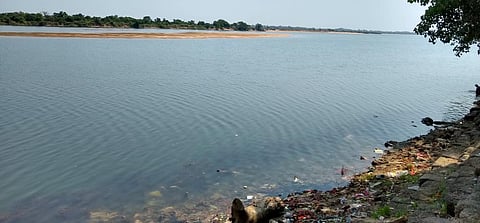

Mahanadi, the lifeline of Odisha, hogged limelight last year when Chief Minister Naveen Patnaik launched a project to save the river. The project, which was considered to be a prelude to the General Elections, is no more on election agenda. While, a year ago, the Bharatiya Janata Party and Indian National Congress had criticised the Patnaik government for the “gimmick” before polls, the issue doesn’t figure in campaigning at all. Not even for Patnaik’s own Biju Janata Dal.
This is when the dying river had immense potential to be an election issue. Except in the monsoons, there is hardly any water in the river, especially downstream. If the water is released from the Hirakud dam in Sambalpur, it takes about 36 hours to reach Cuttack in coastal Odisha. The state government blames Chhattisgarh for lack of water in Mahanadi as the river originates in Dhamtari district and the Chhattisgarh government has allegedly set up seven dams on the river and its tributaries. The water level at Hirakud dam in Sambalpur on the Odisha-Chhattisgarh border remains the bone of contention.
There is a problem of water pollution too. Industrial waste and sewage channels of towns and cities on both sides of the river run into Mahanadi. Farmers suffer because of water shortage and industrial units get to suck the river’s water. Still, somehow Mahanadi could not sustain its political importance. The river met with such a fate because it was more of a political juggernaut for politicians instead of an environmental problem.
Two reasons
There could be two major reasons why Mahanadi dropped off politicians’ radar: One, there was nothing new for politicians to tell people after the government in Chhattisgarh changed and two, the politicians’ lack of commitment towards environmental concerns
In May 2018, Patnaik was worried about the BJP’s growing influence in his state, particularly after the huge victory of the Opposition party in panchayat polls. He took up the Mahanadi issue to counter the saffron brigade by slamming both the central and the then BJP government in Chhattisgarh. It was Odisha chief minister’s political ploy to raise the pitch of ‘Odisha Pride’ in line with Modi’s cry for nationalism to corner his political rival.
“The central government is silent [on the Mahanadi water issue]. The state BJP leaders are supporting the work in Chhattisgarh and here they are shedding crocodile’s tears,” Patnaik said at the valedictory programme of Mahanadi Suraksha Abhiyan at Paradip in Jagatsinghpur district last year.
The water dispute between Chhattisgarh and Odisha is not new. Before Patnaik could launched his abhiyan, the Narendra Modi-led central government had already set up a Mahanadi Water Dispute Tribunal in March 2018 after the Supreme Court’s order to sort out the dispute.
By December 2018, the sheen of the Mahanadi movement had worn off. In Chhattisgarh, the BJP government was replaced by Congress. The main rival of the BJD was no more in power in the neighbouring state and there was no punching bag for Patnaik.
“It was a superficial political fight and now the political parties have nothing to say as the matter lies with the tribunal,” said Ranjan Panda, convener of Odisha Water Initiative. The judges of the tribunal have given one more chance to both the state governments to discuss and settle the matter amicably. Else, they are likely to pronounce their verdict on May 11, 2019.
What worsens the matter is the lack of commitment towards environmental concerns. “The real problem with Mahanadi, more than the Hirakud dam, is the coal blocks. Coal mining and thermal power projects are destroying the river and the basin is getting weaker. Construction of dams is adding to the woes. There is no doubt that pollution is increasing in the river,” said Panda.
For long there have been allegations that Odisha and Chhattisgarh governments are selling water to industrial units and hence depriving farmers. In 2006, about 25,000 farmers made a human chain to protest against this, but nothing happened. There were movements to ‘save Mahanadi’ by some non-governmental organisations, but they fizzled out with time.
In 2018, Sambalpur Municipal Corporation launched Sauchamukta Mahanadi Abhiyan to make it open-defecation free and set up 12 community toilets and fined violators. Still, the problem continues to hurt the river and the people depending on it.
On World Environment Day last year, the Odisha government planned to plant two crore trees on one-kilometre stretch on both sides of the river in its catchment area. But this project too has seen little progress.
The locals, who stay on the banks of Mahanadi, are not really aware or concerned with the issues surrounding the river. They have never heard the politicians talk about the river’s issues during elections.
“I heard my grandfather used to drink Mahanadi’s water. Now it is polluted. We cannot think of drinking the water here. We have no clue what is happening with the water dispute,” said Budhiya Nayak, a daily wage labourer. His hut on the banks of the river gets flooded every monsoon when the water is released from Hirakud dam. He shifts with his family for 3-4 days to some other location every time.
The problem can only be resolved when the government makes a collaborative approach to fight the problem of climate change which is closely related to Mahanadi’s problems, said Panda. “They need to recharge the river. However, it seems this is too much to expect from our politicians,” he added.